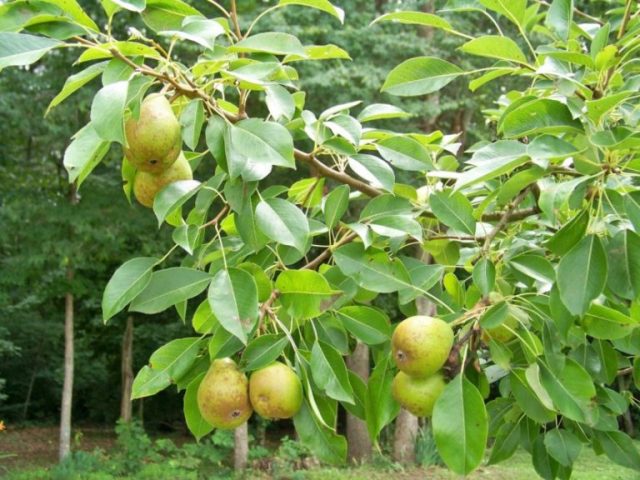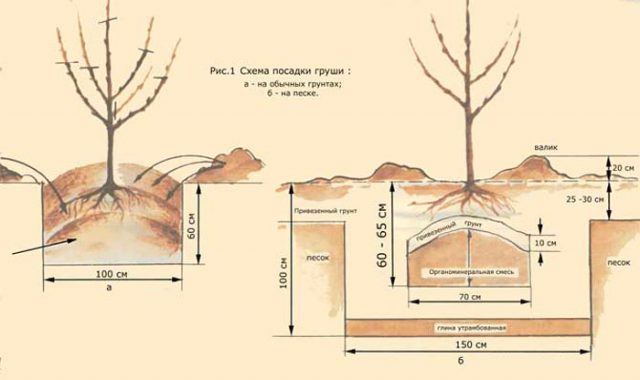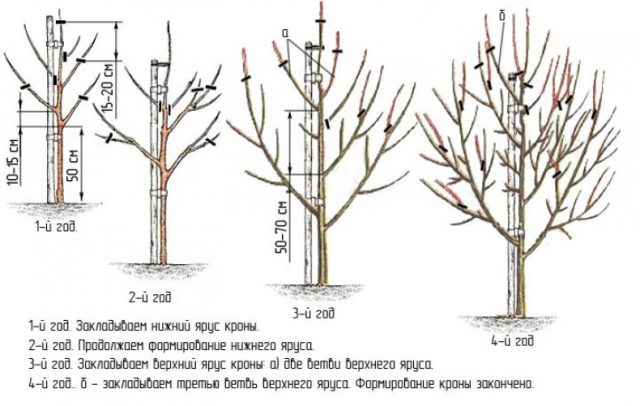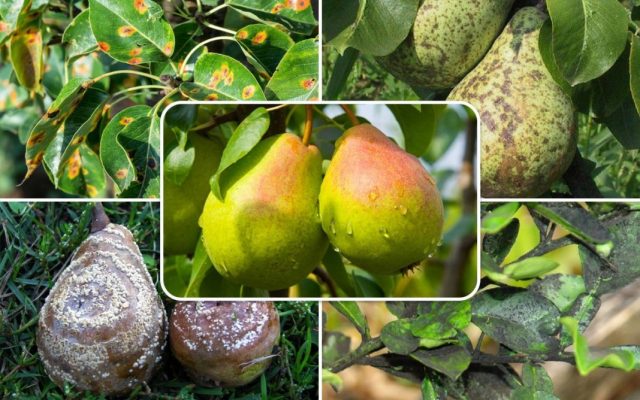Content
Pear Pakham appeared on the Russian market relatively recently. This variety is native to South America and Australia. For its excellent taste, the fruits are loved by many gardeners. The pulp is quite dense, but at the same time juicy, the taste is sweet with a slight presence of acidity. Once harvested, Pakham pears can be stored in a cool, well-ventilated place.
Where does Pakham pear grow
The Pakham pear is a variety of the Bartlett variety. The breeder C. Pekham began to breed the hybrid in the 19th century, after which the tree received the corresponding name.
Fruits were brought to Russia from Chile, Argentina and South Africa. The planting material is suitable for breeding in places with a temperate climate, therefore, it must be taken into account that the seedlings need shelter for the winter.
Description of pear variety Pakham
Ripe fruits of the Pakham variety have an oblong and irregular shape, as a rule, there are small tubercles. The average weight of the fruit is 200 g. The peel is rough, deep green in color, there are blotches. At the time of ripening, the shade changes to yellow or cream.
Young seedlings look like pyramids with a spreading crown. The size of the leaves is medium, there are a few of them on the tree. When the fruits begin to ripen, the branches descend to the ground, making the tree shape irregular. In adulthood, the tree can grow up to 3 m in height. Flowering and fruiting are quite late, the tree can delight with a harvest for about 80 years.
Fruit characteristics
At the time of ripening, the fruits turn yellow, after which the pears become creamy. The pulp is juicy and sweet, crunches when eaten.
Ripe fruits are low in calories, while pears contain a large amount of vitamins, micro- and macroelements. By eating pear varieties Pakham, you can remove toxic components from the body. If you provide optimal storage conditions, then the harvested crop will last in the basement for about 2 months.
Pros and cons of the variety
Studying the advantages of Pakham pear varieties, it is necessary to highlight:
- high level of productivity;
- excellent taste;
- long shelf life of the crop.
According to gardeners, significant disadvantages are:
- rather low level of frost resistance;
- susceptibility to diseases and attacks of insect pests.
Before giving preference to a particular pear variety, it is recommended to study the available features.
Optimal growing conditions
If we take into account the description of the Pakham pear variety and the gardeners' reviews, we can conclude that the seedling is suitable for growing in any regions where moderate climatic conditions are observed. The only drawback is the low level of frost resistance, and the need for shelter for the winter. Without covering work, the root system can freeze, which will lead to the death of the entire tree.
Planting and caring for Pakham pear
To achieve high yields, it is necessary to provide the Pakham pear with proper care.For trees to be healthy, it is necessary to carry out preventive work to combat pests and diseases.
Landing rules
For planting, choose seedlings up to 2 years old and up to 1.5 m high. The branches of a young tree must be flexible, and the root system must be strong. Before planting a Pakham pear in open ground, you should hold the roots in a growth stimulator (for example, in Kornevin or Heteroauxin) for 12 hours, which will allow the seedling to take root much better. After the completion of the work, pear trees should be watered, about 20 liters of water is spent on each root.
Watering and feeding
Fertilizers are applied throughout the year:
- in the spring, liquid fertilizers are used under the roots, in the summer - preparations with a nitrogen content;
- in July, it is recommended to make mineral and nitrogen fertilizing, if necessary, you can add phosphorus;
- in September, nitrogen substances are used;
- before the onset of winter, potassium and superphosphates are added.
Seedlings recently planted in open ground are regularly watered. After watering, the soil is loosened to prevent the formation of an earth crust. So that the water evaporates slowly, the ground around the pear tree is mulched, covered with manure or dry leaves.
Pruning
The formation of young trees begins in the spring, before the onset of the growing season. To do this, the weak side shoots are completely removed, as a result of which the stronger branches easily strengthen the base of the tree.
Pruning of adult pear trees is done 2 times throughout the year:
- in early spring;
- late autumn, when the movement of juices slows down. In this case, it is required to remove old branches and thin out the crown.
Whitewash
Pear Pakham needs to be whitewashed so that the trunk is not susceptible to frostbite and sunburn during the growth process. Otherwise, cracks appear on the tree bark, into which pests, fungal spores penetrate and the process of infection of the fruit tree begins. You can buy a ready-made solution in a specialized store or prepare it yourself.
Preparing for winter
The root system of the Pakham pear needs shelter for the winter. The work algorithm is as follows:
- The barrel is wrapped with paper, cardboard or straw.
- Around the planting pit, remove existing weeds.
- Before sending a tree for the winter, it is watered abundantly.
- Fertilizers can be added if necessary.
In order for the pear tree to withstand low temperatures better, it is necessary to pre-treat the plant with Ekobin or Zircon solution.
Pollination
When growing pears, it is taken into account that there are varieties that are capable of self-pollination, but most pear trees, including the Pakham variety, are self-fertile. If the pollination process occurs naturally, then there will be no result, and the fruits will not set. Forest Beauty, Olivier de Serre, and Favorite Clappa are used as pollinators for this variety.
If necessary, you can pollinate fruit trees yourself. To do this, they purchase a special drug in the store and, according to the attached instructions, carry out pollination of Pakham pears.
Yield
Before proceeding with the planting of planting material, it is recommended to first study the advantages, disadvantages and features of the Pakham pear variety. As a rule, planting should be in a group, you should not plant trees alone, since there is a high probability that the seedling will die.
As a rule, fruiting is abundant. You can start harvesting the finished crop 4 years after the tree was planted in open ground. The period of active fruiting occurs in the seventh year of the tree's life.As experienced gardeners managed to notice, from each specimen you can collect from 80 to 150 kg of ripe fruits.
Calorie content of pear Pakham
The calorie content of Pakham pear is 42 kcal per 100 grams, in addition, the composition includes:
- proteins - 0.7 g;
- fats - 0.2 g;
- carbohydrates - 10.9 g;
- acidity is moderate.
Fruits contain useful substances, but they can negatively affect the gastrointestinal tract, so it is not recommended:
- drink fruit with water;
- eat on an empty stomach;
- combine with meat and curd products.
If you adhere to these recommendations, then Pakham pears will bring significant benefits to the body.
Diseases and pests
Most often, the Pakham pear is affected by rot, fungus and insects. By carrying out preventive measures and timely treatment, you can preserve the health of the tree. Among the common problems, gardeners note the following:
- scab - the fruits of the infected tree begin to crack and stiffen;
- rot - a disease that birds carry, as a result of which growths appear on the fruits;
- black cancer - the tree itself is infected, the bark begins to deform.
To prevent disease, you can use traditional methods or insecticides.
Reviews about pear Pakham
Conclusion
Pear Pakham is prized by many gardeners for its high yield. From each tree, from 80 to 150 kg of ripe fruits are harvested, up to 40 tons of pears are obtained from 1 hectare. The fruits have a large number of advantages: excellent taste, juiciness, long-term storage. Pears of this variety contain many vitamins, so they are recommended for children and adults.












